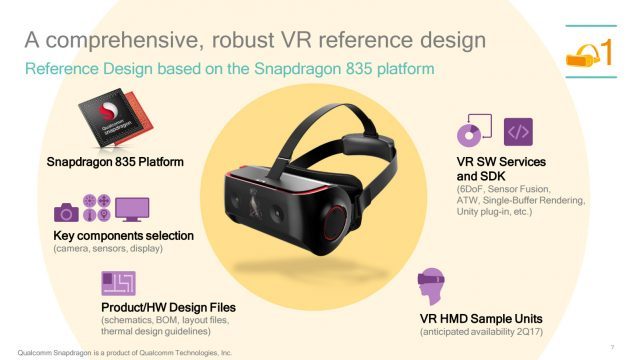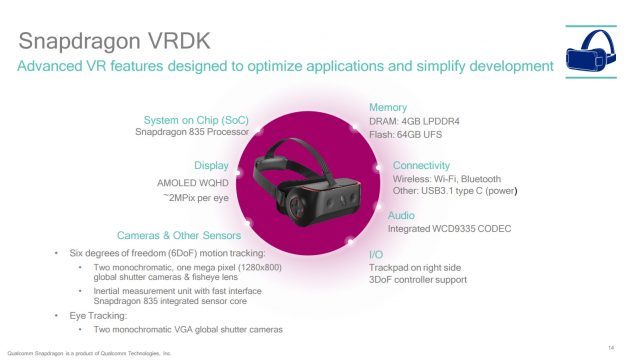Qualcomm’s latest VRDK headset is a reference design that the company has positioned to act as a foundation for consumer electronics makers to create their own headsets based on Qualcomm’s Snapdragon VR hardware. Now with manufacturing partners on board, the first consumer headsets based on the VRDK reference design are expected to launch in the second half of 2017.
Qualcomm’s latest VRDK is built on the company’s new Snapdragon 835 chip. While Snapdragon 835 is suitable for a range of mobile devices like smartphones and tablets, the company says that the chip has also been built specifically with VR in mind.
As part of their VR efforts, Qualcomm has formed the ‘HMD Accelerator Program’ which is designed to “commercialize VR HMDs quickly with fewer resource restrains.” Basically, Qualcomm wants to use its expertise to help companies build their own VR headsets based on Qualcomm’s hardware. This is similar to Intel’s play with their Project Alloy reference headset.
 The root of the HMD Accelerator Program is the Snapdragon 835-based VRDK reference headset, an all-in-one mobile VR headset with inside-out 6DOF tracking, a 90Hz 2560×1440 AMOLED display, 100 degree field of view, 4GB of RAM, eye-tracking, and hand-tracking (via Leap Motion’s new mobile sensor). It’s a complete package that doesn’t require a host PC or a snap-in smartphone. But the VRDK itself won’t be sold, at least not by Qualcomm.
The root of the HMD Accelerator Program is the Snapdragon 835-based VRDK reference headset, an all-in-one mobile VR headset with inside-out 6DOF tracking, a 90Hz 2560×1440 AMOLED display, 100 degree field of view, 4GB of RAM, eye-tracking, and hand-tracking (via Leap Motion’s new mobile sensor). It’s a complete package that doesn’t require a host PC or a snap-in smartphone. But the VRDK itself won’t be sold, at least not by Qualcomm.
Companies can use the VRDK as a starting point for creating their own VR headsets which might not look anything like Qualcomm’s VRDK, but would be built on much of Qualcomm’s hardware and underlying technologies. An Original Equipment Manufacturer (OEM) would choose which hardware and features to keep from the VRDK, and possibly add some of their own to differentiate the device from headsets built by other companies also based on the VRDK.![]()
Qualcomm says that two Original Device Manufacturers (ODM), Goertek and Thundercomm, are the first to join the company’s HMD Accelerator Program. Both companies will offer manufacturing services for OEMs who want a VRDK-based headset built to sell to consumers.
The first of those consumer-ready devices are expected to launch in the second half of 2017, says Qualcomm.
 The company also plans to distribute the VRDK to content creators to stimulate an ecosystem of applications which are specially built to take advantage of the Snapdragon 835 platform and VR headsets built upon it. Those headsets are expected to go out to developers in Q2 2017.
The company also plans to distribute the VRDK to content creators to stimulate an ecosystem of applications which are specially built to take advantage of the Snapdragon 835 platform and VR headsets built upon it. Those headsets are expected to go out to developers in Q2 2017.
All-in-one (AIO) headsets have some clear advantages over mobile shell headsets like Gear VR which require a host smartphone to be snapped into the headset. For one, an AIO headset can be optimally designed for VR, whereas a mobile shell headset is restricted to the limitations of smartphone design (thin, small battery, limited heat dissipation). However, there’s some potential downsides too, the biggest of which is perhaps cost. In order to provide a great VR experience, AIO VR headsets need most of the same hardware that’s already in your smartphone (display, CPU, GPU, sensors, battery etc). That means they could end up being about as costly as a new smartphone.
Qualcomm and its partners haven’t yet announced any pricing information, so we’ll still have to wait and see where the price point falls, and how quickly it will be able to come down to mainstream levels.
Disclosure: Qualcomm and Road to VR co-hosted a networking event this month during GDC 2017.






